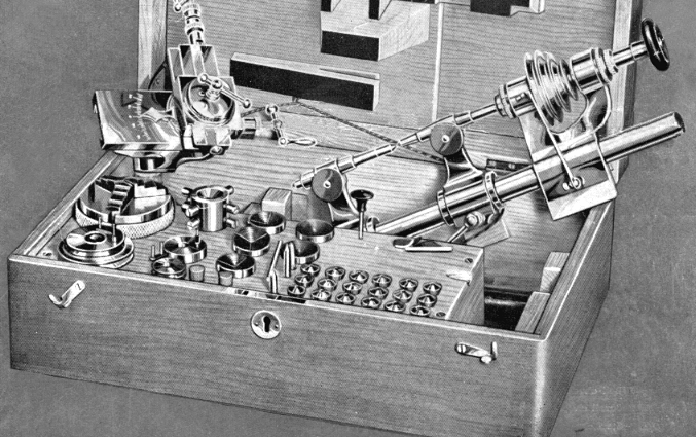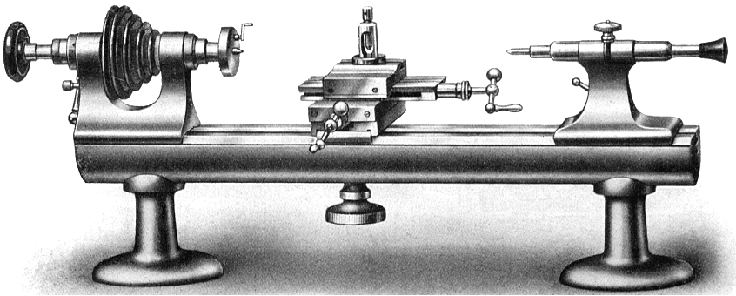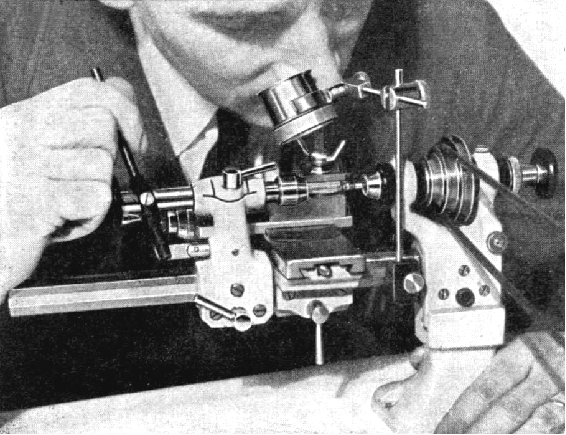E-MAIL tony@lathes.co.uk
- some general notes -
Although there are various designs of watchmakers' lathe, some dating back to the late 1700s and including specialised models - for example "fiddle" lathes, "steel turns", Jacot, Swiss, Swiss Universal (also called the English Mandrel) Bottum and Dracip - more modern examples can generally be divided into two types: the lighter "Geneva" and heavier "WW". The "Geneva" can be recognised by a round bed, with a flat machined along the back for its full length and nearly always supported on a single foot. These lathes, invented in 1859 by Charles S. Moseley in the U.S.A., generally take a 6mm or 8mm collet and were designed only for lighter, very high-precision work. The "WW" (Webster-Whitcombe), is the more popular and versatile machine and also of American origin, from around 1889. The centre height of the WW was usually 50 mm, though very occasionally 65, 70 mm and other figures are encountered. The bed was of heavy construction, formed with a 37 mm-wide flat on the top and a 60-degree bevel along each edge, and carried a headstock spindle to accept 8, 10mm or 12mm collets. Larger than the WW type are what might be called "toolmakers' or "bench precision" lathes: these vary in size from the Schaublin 65 and 70 (the latter being the most popular and frequently-encountered machine in the professional watchmaker's workshop) to larger examples such as the Schaublin 102 and models by makers such as Boley, Lorch, Leinen, Stark, American Watch Tool Company, B.C. Ames, Wade, Pratt & Whitney, Rivett, Cataract, Hardinge, Elgin, Hjorth, Potter, Remington, Sloan & Chace and others. Whilst useful machines in a precision workshop these are outside the scope of this article.
There were dozens of brands of watchmakers' lathes and a lot of "badge engineering" went on. This was compounded by accessories being interchangeable between makes so it is entirely possible that a lathe has been "made up" from others. However, it's very unlikely that the bed, headstock and tailstock will be from different manufacturers; if they are, be wary.
You can see other examples of watch and instrument makers' lathes and their accessories here:
odkaz
http://www.lathes.co.uk/pultra
http://www.lathes.co.uk/boley/page3.html
http://www.lathes.co.uk/boley/page4.html
http://www.lathes.co.uk/boley/page5.html
http://www.lathes.co.uk/boley/page6.html
http://www.lathes.co.uk/boley/page7.html
http://www.lathes.co.uk/moseley
http://www.lathes.co.uk/bergeon
http://www.lathes.co.uk/btm
http://www.lathes.co.uk/levin (USA)
http://www.lathes.co.uk/derbyshire (USA)
http://www.lathes.co.uk/favorite
http://www.lathes.co.uk/ime
http://www.lathes.co.uk/lorchschmidt
http://www.lathes.co.uk/lorch
http://www.lathes.co.uk/derbyshire
http://www.lathes.co.uk/btm
http://www.lathes.co.uk/ime
http://www.lathes.co.uk/leinen
http://www.lathes.co.uk/rolls-royce
Continued below:

|
|

|
An English-made BTM "Geneva" pattern watchmakers' lathe (note the bar-like bed) complete in its maker's fitted wooden box with a range of useful accessories. The item top left in the box is the most valuable item - a compound slide rest, used to hold cutting tools and feed them to the work with the aid of two screw-controlled slides. |
||

|
Boley Lathe No. 1b. A "WW" pattern lathe of a heavier pattern, admitting 230 mm between centres, and with feet at both end of the bed. On this model the compound slide was fitted as standard. |
||

|
|
||

|
This is a later type of Boley & Leinen "Reform" lathe, manufactured from the early 1950s. The mouth-watering outfit was listed as the No. 77/X1V and contains virtually everything a skilled watch-repair man could wish for including, top left, a second headstock fitted with a permanently mounted and hence very accurately aligned faceplate. |
||
|
Continued: |

|
A Swiss-made Bergeon Model C of the "Geneva" type. This example is fitted with a compound slide rest to hold the cutting tool, a lever-action tailstock and, to assist with very small work, a magnifying glass held on an articulated arm |
||